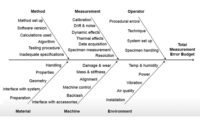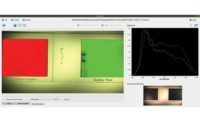Accurate and Repeatable Measurement
Using a rotary table on a CMM will improve process efficiency and productivity by reducing setup and process times.

Using a rotary table on a CMM will improve process efficiency and productivity by reducing set up and process times. Source: RPI

Rotary tables increase a CMM’s available measuring volume. Source: RPI

A rotary table will significantly improve overall measurement accuracy of a CMM. Source: RPI



Accuracy and repeatability is the lifeblood of all CMMs. If they aren’t accurate, there’s no point in having them. However, the degree of accuracy required is dependent on the particular application. For manufacturing gas turbines and aircraft engines, a very high degree of accuracy is often required.
Now imagine that you want to walk in a perfectly straight line for a half-mile. And imagine that at the end of that walk, you find that you are ±2.5mm (one tenth of an inch) out. You’d be pretty pleased. In the world of golf, you’d also be pretty pleased if you scored a hole in one every time you teed off to a green 14 miles away!
Well, that level of accuracy can be achieved with high precision rotary tables. These can deliver precision geometry with axial performance well below 0.0005mm and positional accuracies to ±0.5 arc-seconds (±0.00014°).
Using a rotary table on a CMM will improve process efficiency and productivity by reducing setup and process times. A rotary table will also greatly increase a CMM’s available measuring volume thereby providing greater flexibility in what can be measured. And last but by no means least, a rotary table will also significantly improve overall measurement accuracy of a CMM, thereby reducing uncertainty.
Rotary tables enable very precise measurement of many geometrical characteristics, including angle, roundness, concentricity, parallelism, flatness and runout. They are used with: probes such as plunger, transducer and capacitance; optical such as autocollimator and laser interferometer; and electrical: oscilloscope and voltmeter.
Rotary tables enable accurate measurement of symmetrical/prismatic components such as rotor discs. In the measurement of a rotor disc, a CMM without a rotary table would require a machine with a large measuring volume. However, deploying a rotary table will reduce this volume significantly. This is because the volume of the CMM is directly related to the diameter of the disc as voluminous styli systems are usually required to measure a workpiece from all sides. This means a large proportion of its measuring range is required just to ensure collision free movement of the stylus around the part.
However, the introduction of the rotary table removes this requirement as the rotor can be presented directly to the stylus removing the requirement to access all sides. This in turn simplifies the stylus system allowing the measurement of larger workpieces in relation to the available measuring range, saving aerospace manufacturers both time and money.
As well as significantly improving overall measurement accuracy and reducing uncertainty in CMMs, rotary tables also greatly increase a CMM’s available measuring volume thereby providing greater flexibility in what can be measured.
Some tables have been specifically designed as a fourth axis for any high precision CMM to simplify measurement procedures, increase application range and measuring volume of symmetrical or prismatic components, including scanning applications. This is particularly important for large turbine disks for gas turbines or for airplanes. However, they are also starting to gain traction for smaller, lower measurement volume applications typical in the automotive industry.
For larger applications, some circular geometry inspection and assembly system can reduce inspection times by 90% and improve gage R&Rs by up to 10 times.
Air bearing spin tables are becoming more popular and rely on air lubricated hydrostatic bearings which provide very high radial and axial stiffness. This type of bearing offers significant advantages over conventional rolling element bearings permitting operation with minimal drag, vibration and mechanical noise.
The design of these bearings ensures axial laminar flow between shaft and housing compared with conventional orifice entry arrangements thereby ensuring exceptionally good motion geometry of less than 0.0001mm for axial and radial runout.
These tables can be combined with direct drive motors and high accuracy angular encoders. The encoder couples directly to the motor control system, which has its own high-resolution interpolator ensuring precise positioning and repeatability.
It is possible to fit a table with a high accuracy Hirth Coupling, which provides location and angular positioning of the tabletop. This delivers fast, accurate indexing between pre-set positions.
Rotary tables are so accurate that they can be forgotten, when using a CMM. And that’s no bad thing for manufacturers who need precision time and time again.
Looking for a reprint of this article?
From high-res PDFs to custom plaques, order your copy today!








